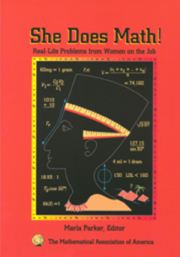Book contents
- Frontmatter
- Preface
- Contents
- Problems by Subject
- Environmental Psychology
- Software Engineering; Computer Science
- Archaeology
- Mathematics and Computer Science
- Civil Engineering
- Mathematics
- Electrical Engineering
- Physics; X-ray Astronomy Research
- Mathematics
- Physics; Astronaut Crew Training Instructor
- Business Data Processing
- Software Engineering; Real Estate Investment
- Quality Engineering
- Health Science
- Nursing Education
- Electrical Engineering; Space Systems
- Oil and Gas Accounting
- Business Administration Higher Education
- Aerospace Engineering
- Structural Engineering
- Computer Science
- Mathematics
- Dietetics—Foodservice Management and Nutrition
- Electrical Engineering
- Chemical Engineering, retired
- Software Engineering
- Immunology and Microbiology
- Mechanical Engineering
- HMO Pharmacy Practice and Management
- Ophthalmology
- Electrical Engineering
- Fish Pathology
- Computer Science and Computer Graphics
- Mathematics and Computing
- Electrical Engineering
- Astronomy
- Author
- Mathematics
- Reflections on WAM
- Solutions
Electrical Engineering
- Frontmatter
- Preface
- Contents
- Problems by Subject
- Environmental Psychology
- Software Engineering; Computer Science
- Archaeology
- Mathematics and Computer Science
- Civil Engineering
- Mathematics
- Electrical Engineering
- Physics; X-ray Astronomy Research
- Mathematics
- Physics; Astronaut Crew Training Instructor
- Business Data Processing
- Software Engineering; Real Estate Investment
- Quality Engineering
- Health Science
- Nursing Education
- Electrical Engineering; Space Systems
- Oil and Gas Accounting
- Business Administration Higher Education
- Aerospace Engineering
- Structural Engineering
- Computer Science
- Mathematics
- Dietetics—Foodservice Management and Nutrition
- Electrical Engineering
- Chemical Engineering, retired
- Software Engineering
- Immunology and Microbiology
- Mechanical Engineering
- HMO Pharmacy Practice and Management
- Ophthalmology
- Electrical Engineering
- Fish Pathology
- Computer Science and Computer Graphics
- Mathematics and Computing
- Electrical Engineering
- Astronomy
- Author
- Mathematics
- Reflections on WAM
- Solutions
Summary
When I was in high school, I didn't know what I wanted to do for a career. Science— especially astronomy, nature, the human body, and archeology—was always fascinating to me, so I knew I wanted to go into a technical field. During all four years in high school, I studied math, including algebra, geometry, trigonometry, advanced math, and introductory calculus.
Once in college, I decided to go to medical school and become a doctor, so I started the pre-med program while also working parttime. The competition to get into med school was fierce, and I soon realized my grades were not good enough. One weekend, I went to the annual Engineering Fair, presented by the School of Engineering. There I saw an experiment in biomedical engineering that was fascinating. A digital-analog (or hybrid) computer was modeling the human circulatory system. Students used this computer model to simulate heart attacks, arrhythmias, and other heart problems. Later, I talked with several engineering professors, and realized I could get a degree in electrical engineering, specializing in biomedical engineering. In this way, I could work in a medically-related field. My decision was made. I went on to major in electrical engineering at the University of Wisconsin in Madison.
In college, I studied algebra, calculus, differential equations, linear algebra, and physics because they were prerequisites for the engineering courses. Computer science and statistics were also required.
- Type
- Chapter
- Information
- She Does Math!Real-Life Problems from Women on the Job, pp. 142 - 145Publisher: Mathematical Association of AmericaPrint publication year: 1995

